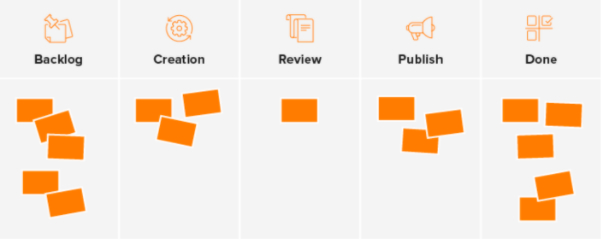In 2019, DoorDash was losing money on the average order and reported an operating loss of $616 million on $885 million in revenue. By the end of 2020, their revenue jumped to $2.89 billion — a 226% gain.

Why the sudden success?
For one, the global pandemic spiked the demand for food delivery. But DoorDash also responded to customers’ needs right from the start. They delivered COVID test kits and launched the #OpenforDelivery campaign to support restaurants by the end of March, made it easier to filter customer ratings in April, and released a Gifting feature to send loved ones food over the holidays.
Simply put, they figured out what customers desired and rapidly delivered.
Now more than ever, customers expect brands to understand and respond to their needs. In a survey of global consumers, 58% of people remembered a brand that quickly pivoted and 82% ended up doing more business with that company as a result.
But a lightning-fast response only happens if your team can handle abrupt change.
Agile marketing is a strategic approach that focuses on quickly executing projects by working in short sprints. It makes room for marketers to shift their focus, adapt to customer needs, and change priorities alongside expectations.
With Agile, what once took months to deliver can take weeks.
Adopting this approach takes work, but this post shares how to get started with Agile marketing by explaining the process, sharing examples, and showing you how to automate your efforts.
What is Agile Marketing?
Agile marketing is a strategic marketing approach that prioritizes creating high-value deliverables, working in short, intense bursts to achieve goals, and rapidly iterating.
By the end of each burst — often called a ‘sprint’ or an ‘iteration’ — teams complete their outlined deliverables and begin testing so they know how to improve during the next iteration. Data collection and analytics allow teams to incrementally refine and improve the results over time.
Agile marketing embraces failure. It also requires teams to learn from their mistakes and make adjustments to continuously get better. This mindset isn’t always easy for teams to instantly adopt. That’s why it’s important to understand the core values outlined in the Agile Marketing Manifesto before switching to this approach.
- Validated learning over opinions and conventions.
- Customer-focused collaboration over silos and hierarchy.
- Adaptive and iterative campaigns over Big-Bang campaigns.
- The process of customer discovery over static prediction.
- Responding to change over following a plan.
- Many small experiments over a few large bets.
When these values play out in real-world projects, the impact can be massive.
Research by McKinsey found that digital marketing organizations using Agile have seen a 20-40% increase in revenue. Agile has also cut down the time it takes for companies to turn an idea into an offer — from multiple months or weeks to less than two weeks.
You may think this acceleration leads to sloppy deliverables and disappointment. It’s the opposite. Agile marketing can improve performance and quality by creating space for clear goals, frequent feedback, continual testing and iteration, on-time deliverables, and inevitable impact.
To get those results, you have to dive into the nitty-gritty details.
Agile Marketing Process
No marketing team follows the exact same Agile approach. Some stick to the traditional frameworks while others pick and choose which parts work for them to create a hybrid method.
The method you choose can depend on the goals you want to accomplish. While its roots are in web and software development, 77% of companies using Agile rely on it for creative services, content creation, and operations.
The main methodologies for Agile marketing teams are Scrum and Kanban.
Scrum
The Scrum framework revolves around sprints. Each sprint lasts for two to six weeks and is organized by the team doing the work. Depending on the size of your project, you may need to break it up into multiple smaller sprints to tackle it bit by bit.
The goal of each sprint is to rapidly deliver small projects that can be combined into a larger project over time. Once a sprint is set, the team shouldn’t change its goals or reprioritize until the sprint is complete.
To make sure your sprints stay on track, use dedicated scrum tools, and establish a few key roles and meetings.
Roles
1. Scrum Master
This person is responsible for keeping the team on task. They know the Scrum framework and use it to facilitate meetings, remove roadblocks, help team members use the framework, and make sure everyone on the Scrum team is collaborating and communicating.
2. Product Owner
This person understands the reason for the work and makes sure the process is being done at the right time. They understand the customers better than anyone else, and they collaborate with the stakeholders and team to ensure the deliverables provide value to the business and to customers.
3. Developer
Everyone else on the team falls under the Developer role. Ideally, the people in this role are cross-functional and contribute a unique set of skills needed to accomplish the sprint. You want to choose at least one person from each department that your project touches.
Meeting
1. Planning
A planning meeting kicks off every sprint to decide what the team can achieve. Everyone looks at the priorities the Product Owner has put together and agrees on which to include in the sprint.
The project(s) are divided into tasks, given deadlines, and assigned to individual team members so people know exactly what to work on when they leave the meeting. These meetings take time, so dedicate at least one hour per week of the total sprint time (i.e., a three-hour meeting for a three-week sprint).
At your first planning meeting, emphasize that Agile is a new way of working and the typical rules don’t apply. Reiterate the need to focus on the customer above all else and highlight the need for speed, collaboration, data, and accountability.
2. Stand-up
The daily stand-up gets your team together for a brief (15 minutes or less) check-in. The aim is to make it very clear where everyone is on progress, roadblocks, and tasks. Everyone on the team answers:
- What they accomplished yesterday
- What they plan to do today
- Any blocks in their way
3. Review
The review is the time to show off what your team has achieved during the sprint. It’s open to anyone interested in the results and is a good time to show off campaign materials, demo content, or share early testing data.
Make note of feedback and add or adjust your priority list as needed, but don’t get wrapped up in additional approvals or new ideas. The point is to share insight into what your team is working on and highlight the impact.
4. Retrospective
Headed by the Scrum Master, this meeting is a chance for the Scrum team to reflect on work from the latest sprint. Everyone shares what went well, what didn’t, what can be improved, and lessons learned. Make sure people don’t point fingers in the meetings, and assign action items as a way to continually improve before the next retrospective.
Kanban
If your marketing team is full of visual learners or does work that won’t fit well into a predetermined sprint timeline, Kanban may be the Agile framework for you.
Kanban is made up of three main components: visualizing workflow, setting WIP limits, and meeting cadences.
1. Visualizing workflow
Unlike Scrum, Kanban uses visual cues to track progress. A Kanban board is how people track the progress of user stories (i.e., tasks) to be accomplished. The board is divided into columns, each their own stage in a workflow.
The simplest boards have To-Do, Doing, and Done columns, but the more complex your workflow, the more columns you may need. (One of my favorite tools for building boards and tracking progress is Miro or other Kanban templates).

Each card on the board represents a task to be completed. For example, if you’re planning a social calendar for the upcoming quarter, you would list each task that needs to be accomplished on its own card (i.e., choose topics, assign copy, write copy, schedule posts, and so on).
As the task is being completed, you move the card into the corresponding column. A quick glance at the board and everyone on your team knows how the project is progressing and what still needs to be done.
2. Setting WIP limits
When people have too much on their plates, nothing gets accomplished. This is why Kanban uses WIP limits — boundaries that outline how people will work on the tasks within each column on the Kanban board.
Placing limits on how many tasks can be in one column or how much time people have to accomplish a task. Let’s say you want your social coordinator to schedule the posts for each month before they begin reviewing posts for the following month. That rule means they can’t move the “Review posts” task into the “Doing” column before the “Schedule posts” are in the “Done” column.
Setting ground rules helps people focus on finishing a specific goal or task before starting another one. In a world of context switching and mental burnout, limitations are a way to achieve your goals without juggling too many tasks at once.
3. Meeting cadences
Similar to Scrum, Kanban is designed to help teams work better and accomplish their goals. It incorporates planning meetings, daily stand-ups, and retrospectives to make sure a project is on task and continually refined.
The one meeting that’s different from Scrum is the delivery meeting, a time to plan when to release the content or project. Since Kanban works on longer timelines than Scrum, the delivery meeting is the place to bring in other groups that may need to help get the work out.
While a small team may own a project, a successful Agile marketing strategy relies on everyone. It’s helpful to bring in outside team members to collaborate on timelines, share feedback, and assist in launching the work your team accomplishes.

